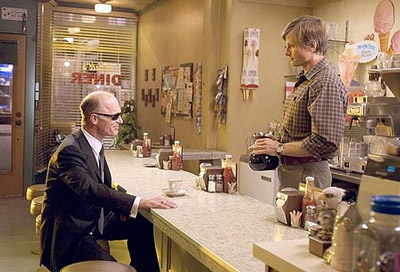
A History of Violence
directed by David Cronenberg
starring Viggo Mortensen, Maria Bello, Ed Harris, William Hurt
New Line
What is violence? Is it necessarily a bad thing, something to be avoided at all costs? In A History of Violence, director David Cronenberg (The Fly, Dead Ringers, Naked Lunch) takes an unblinking look at this very basic human trait, and makes the viewer consider the subject from several angles.

Perhaps the most surprising thing about the film is the contrast between its objective and subjective levels of violence. Sure, a film like Kill Bill (both volumes) has far more blood, gore, decapitation, evisceration and generally graphic depiction of untimely fates … but A History of Violence, with its rural Indiana setting and constantly ominous feeling of “something bad’s gonna happen,” makes its occasional bursts of gunplay and street fighting far more effective and disturbing.
The movie begins by introducing a couple of unsavory characters. Their calm, business-as-usual banter as they check out of a dilapidated motel obviously in the middle of nowhere is unsettling – it’s hard to shake the feeling that these are indeed the bad guys, and their easy demeanor marks them as true sociopaths who take whatever punching, bashing and killing needs to be done in the same stride as brushing their teeth. Once their brutal introduction is complete, we switch to a snapshot of Tom Stall (played by Viggo Mortensen) and his idyllic life. Tom owns a diner in a small Midwestern community, the type that brings echoes of the Andy Griffith show to mind. He’s got a teenage son, a young daughter, and a loving wife (Maria Bello, The Cooler). Life may not be too exciting, but the family enjoys their day to day existence. Tom’s diner seems to be scraping by, and son Jack’s life is constantly menaced by a typical jock/bully, but overall … things are good.

Of course, the audience knows that the Stall family is on a collision course with Bad, and it arrives in the form of our two In Cold Blood-like characters, who are low on cash and decide the diner would make a good ATM. It’s unfortunate – for them. In an inspired burst, Stall foils the robbery and the bad guys leave town in body bags instead of in the money. This transforms Stall into an instant hero, and puts the audience in an uneasy state. Is that it? The movie’s just getting started … there should be more violence coming.
Needless to say, this is merely the setup for the real conflict in the movie, which arrives in the form of some obvious city-slickers showing up at the now-crowded diner. Wiseguy Carl Fogarty (done to perfection by Ed Harris) seems to think Tom is some mobster he knew in Philly named Joey Cusack. Correction – he’s dead certain that he’s found Joey, and he knows some people back in Philly who’d like to have a word with him. Tom denies knowing who Fogarty is talking about, and is puzzled and afraid of this strange turn of events, as he fears for the well-being of his family.
As this case of mistaken identity plays out, we’re treated to all sorts of menace and tension. Sometimes things explode in bouts of the expected violence, other times, there’s an uneasy backing off from what seems to be an inevitable confrontation. It’s also worth mentioning that the two sex scenes in this film, one loving and another not, are just as unflinching as the violent ones. This is clearly not a Hollywood movie; there’s no cutting away as the music swells, and though the onscreen copulation doesn’t go as far as showing genitalia, very little is left to the imagination.
“A History of Violence 3”
A History of Violence is one of those rare films whose themes will haunt you for some time afterward. It’s not passing judgment on violence; it’s not saying that it’s a necessary evil, an unnecessary one, or anything other than, well, it’s unavoidable. Perhaps if the world were populated entirely by Buddhist monks, we would never be forced to resort to physically hurting each other, but really, that’s a long shot. I’m sure there’s still a few bad apples in those Tibetan monasteries. The truth is that there are some mean people out there, and sometimes the only language they understand is the one spoken with fists, knives and bullets. That message is pretty clear.
A History of Violence: http://www.historyofviolence.com












